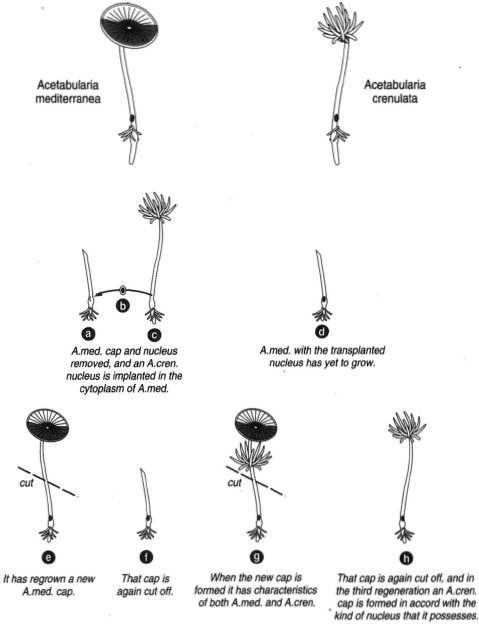Acetabularia: A Green Alga
While working with the green marine alga Acetabularia in the early 1930s, Joachim Hammerling observed that the cell continued to produce a particular protein for up to two months after the nucleus had been removed. This seemed to indicate that the mechanism of control of protein synthesis resided in the cytoplasm. Hammerling wanted to determine the extent to which the nucleus controlled cellular functions.Acetabularia, romantically called “the mermaid’s wineglass,” can reach a height of two to ten centimeters; yet it is a single-celled form possessing only one nucleus throughout most of its life. As shown in figure 16-10, it has a foot, a stalk, and a cap. During growth, the nucleus enlarges to approximately twenty times its original diameter, making it a convenient candidate for nuclear studies. Different species exhibit different kinds of caps. Acetabularia mediterrunea has a round cap, while A. crenulata has a jagged cap.
Using microdissection techniques in a first series of experiments, Hammerling removed the nucleus of an A. mediterranea and replaced it with the nucleus of an A. crenuluta. He then cut off the cap and waited for the cell to regenerate a new one. The regenerated cap took the same form as the original cap. When this cap was then also removed and a second-generation cap regrew, it took an intermediate form between the original cap and the cap of A. crenulata. When this cap was in turn removed and a third-generation cap regrew, the new cap was entirely of the crenuluta form-in accord with the kind of nucleus that had been placed in the cell.
Although it took three generations of regenerating the caps of Acetabularia, we now clearly understand that the nucleus governs what goes on in the cytoplasm. In the first-generation regrowth, the cytoplasm already possessed programming from the original mediterruanea nucleus. In the second generation regrowth, residual chemical information from the original nucleus mixed with new programming chemicals from the replacement (crenuluta) nucleus. In the third-generation regrowth, the influence of the original (mediterranea) nucleus had been exhausted, and the new nucleus of A. crenuluta was entirely in control.
 |
| Figure 16-10 At top left, Acetabularia mediterranea at the top right, A. crenulata. (a) The
cap of A. meditenanea is removed, as is its nucleus (b) The nucleus of A. crenulata is implanted
in the cytoplasm of A. meditemnea. (c) A. crenulata, the source of the implanted
nucleus. (d) A. meditenanea with the transplanted nucleus has yet to grow. (e) A. mediterranea regrows an A . meditenanea cap, which is again cut off, (f). (g) When the new cap
forms, it has characteristics of both A . meditenanea and A . crenulata. (h) When this cap is
removed, the third regeneration is an A. crenulata cap, in accord with the transplanted nucleus. |




